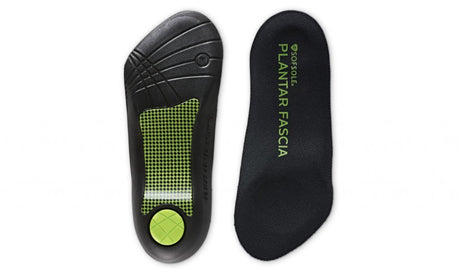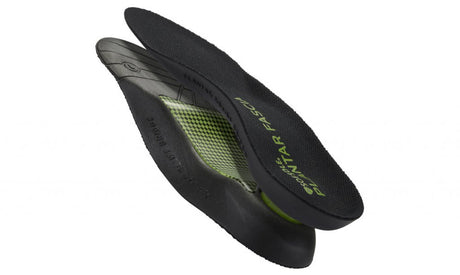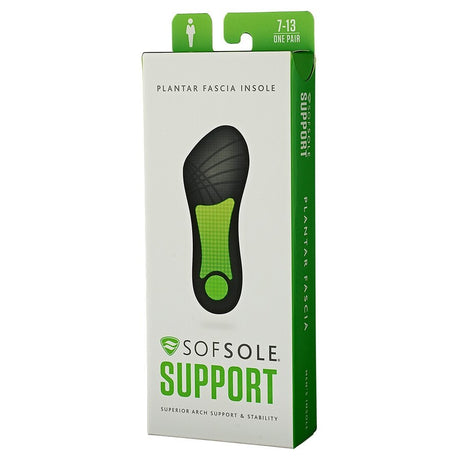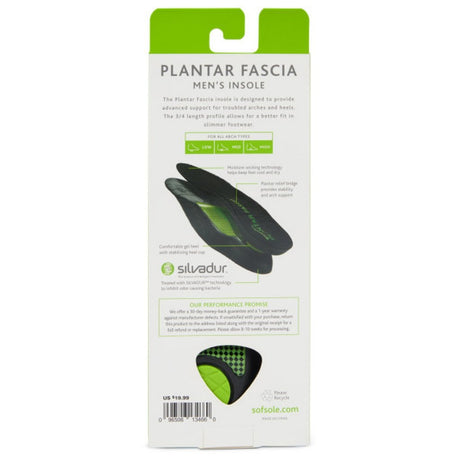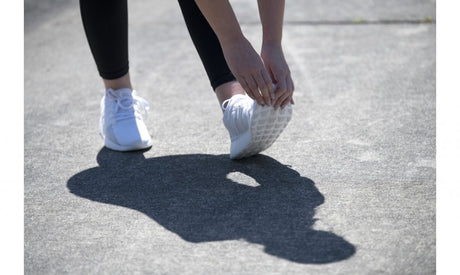- Up to 8% off
Insoles for heel spurs - Plantar Fascia 3/4
Sale price €27,51 EUR Regular price €29,90Unit price /Unavailable - Regular price €4,88 EURUnit price /Unavailable
Heel spur sock - No show - Black - FS4 from OS1st
Regular price €31,13 EURUnit price /Unavailable- Regular price €19,88 EURUnit price /Unavailable
- Regular price €13,90 EURUnit price /Unavailable
- Regular price €37,38 EURUnit price /Unavailable
Heel cup for heel spurs - Black
Regular price €22,38 EURUnit price /Unavailable- Sale price €14,90 EUR Regular price €29,90Unit price /Unavailable
FS6+ Sock for heel spurs - Black
Regular price €60,42 EURUnit price /UnavailableFS4+ Running sock, heel spur/shin splints - White
Regular price €49,27 EURUnit price /Unavailable
WHAT ARE THE SYMPTOMS OF HEEL SPURS?
Heel spurs can be felt in different ways, but some of the most common symptoms are.
- Pain under your foot when you have just woken up.
- Pain in the heel pad when you have been sitting still for a long time and are travelling. The pain is quite similar to that in the morning, but possibly slightly milder.
- Pain or cramping in the plantar fascia under load. The pain often decreases as the foot warms up.
- Pain in the heel under load.
- Heel spurs can also cause pain at rest. It mainly affects people who have jobs that involve a lot of standing and walking. After a day of heavy exertion, it is common to have a throbbing pain that persists even when resting.
WHY DO YOU GET HEEL SPURS?
Heel spurs are an overload injury when the arched foot tendon has been strained and the body has been subjected to stresses that it cannot cope with. For example, it is common for the pain to occur if you increase the training dose at a faster pace than the body can handle. The root cause of the pain can often be located elsewhere than in the foot; for example, the reason may be that you have an imbalance in the hips, fabric and legs, which means that the body cannot cope with the exercise you are exposed to. You can also get heel spurs if you change your "foot behaviour". For example, if you are not used to walking barefoot and start doing so, or if you increase your use of flat shoes. Problems with heel spurs can also be exacerbated if you have an eye or low arches, or if you are overweight.
CAN YOU DO ANYTHING YOURSELF TO RELIEVE/HEAL HEEL SPURS?
What is important during the healing process is to listen to your body and not put it under unnecessary stress. Heel spurs normally heal on their own, although it can take a long time, up to 2 years, and during the healing period there are some things to consider that will help the healing process and reduce the risk of pain increasing or returning:
Rest
If it hurts, it's good to rest and let your body recover. If you ignore the pain and carry on as usual, it can be doubly punishing after a while.
Use inserts for heel spurs
There are insoles and inserts specifically designed for people with heel spurs. They provide good cushioning and pain relief while helping the heel to heal faster.
Exercise
It is important to start exercising to increase function and mobility and to build up strength in the foot. There are rehab exercises specifically designed to alleviate heel spurs. For example, toe raises are a classic exercise done daily for faster healing. An exercise programme can be developed together with a physiotherapist. It is important to do rehab training in the right dose; not too little and not too much.
Invest in comfortable shoes
Check your shoes to make sure they are not broken or poorly constructed. Prioritise your comfort and wear shoes with sturdy soles and good shock absorption.
Work on your running technique
Once you're up and running again, your running technique can be crucial to avoid re-injury. For example, to avoid heel spurs, it is recommended that you put your forefoot at the front of your stride (and not your heel).
HOW DOES A SOCK HELP AGAINST HEEL SPURS?
There are two types of socks for heel spurs, day socks & night socks.
Daytime socks are used during the day to support the arch of the foot and relieve the heel through compression. This speeds up the healing of the injured area. It is also possible to use daytime socks at night.
Night socks are worn when you are sleeping. It stretches the muscles on the underside of the foot and gives more mobility. This reduces pain.
At present, we at Sportsmart only have daytime socks in our range of socks for heel spurs.
WHAT SIZE IS RIGHT FOR ME?
When it comes to socks for heel spurs, it is very important to find the right size for the sock. Too small or too big will not give you the support and relief you are looking for. Take the time to make sure you have the right size.
TAPE OR SOCK FOR HEEL SPURS?
The socks you use during the day, such as OS1st FS6, have the same basic idea as taping your feet against heel spurs. What is best depends on what suits you. A heel spur sock is easy to use and rarely causes problems. The important thing is to find a sock that fits your foot well. Taping can work exceptionally well and provide amazingly fast relief. But it requires a bit more than using socks. Firstly, you need to understand how to tape. Then you need to have a good tape and change the tape regularly, preferably every day or at least every other day. Another risk with tape is that it can irritate the skin and cause a rash. If this happens, just stop the treatment immediately.
IS IT DANGEROUS TO RUN WITH HEEL SPURS?
It is a bad idea to try to endure the pain and just train as usual if you start to feel heel spurs. This is because the worse the pain gets, the harder it is to get rid of. And if you develop full-blown heel spurs, it can be a very long break from running.
GETTING RID OF HEEL SPURS - TIPS & TRICKS
Heel spurs are common and can take a really long time to get rid of. There is also a risk of recurrence if you don't continuously take care of your feet. Here are some general tips to help you live with and get rid of heel spurs.
REVIEW YOUR FOOTWEAR
Choose stable shoes that support the arch and have a thick, soft sole. Avoid high heels and flat ballerina shoes.
TAKE AN ANTI-INFLAMMATORY TABLET
Anti-inflammatory painkillers are a good first step if the pain is severe.
STAND STRAIGHT & JUST ENOUGH
Avoid standing and walking for long periods, especially on hard surfaces. If you stand and work on the same hard surface all day, it's a good idea to get really good shoes and inserts.
TAKE IT EASY WITH YOUR RUNNING
If you are already suffering from heel spurs, swap running for other forms of fitness training, such as cycling or swimming, for a while. Also avoid training sessions with lots of jumps.
And when you want to start running again after the heel spur has disappeared; don't go too hard but increase the distances very slowly. Let it take time to get started!
STRETCHING THE FOOT
Stretching the sole of the foot several times a day has proven to be effective, both in getting rid of heel spurs but then also in reducing the risk of recurrence. Toe raises are a classic and simple exercise that can be done with or without hand weights. It works well at home on the stairs.
USE ASSISTIVE DEVICES
Feel free to use inserts and socks in your shoes to relieve pressure on the heel. You can also try taping your foot. Taping can both relieve the foot and reduce the pain. The foot should be taped for 5-6 weeks and the tape should be changed regularly. You can go to a physiotherapist to have your foot taped, or do it yourself.
CHECK YOUR WEIGHT
If you are overweight, losing weight can help. Being overweight is one of the most common risk factors for heel spurs.
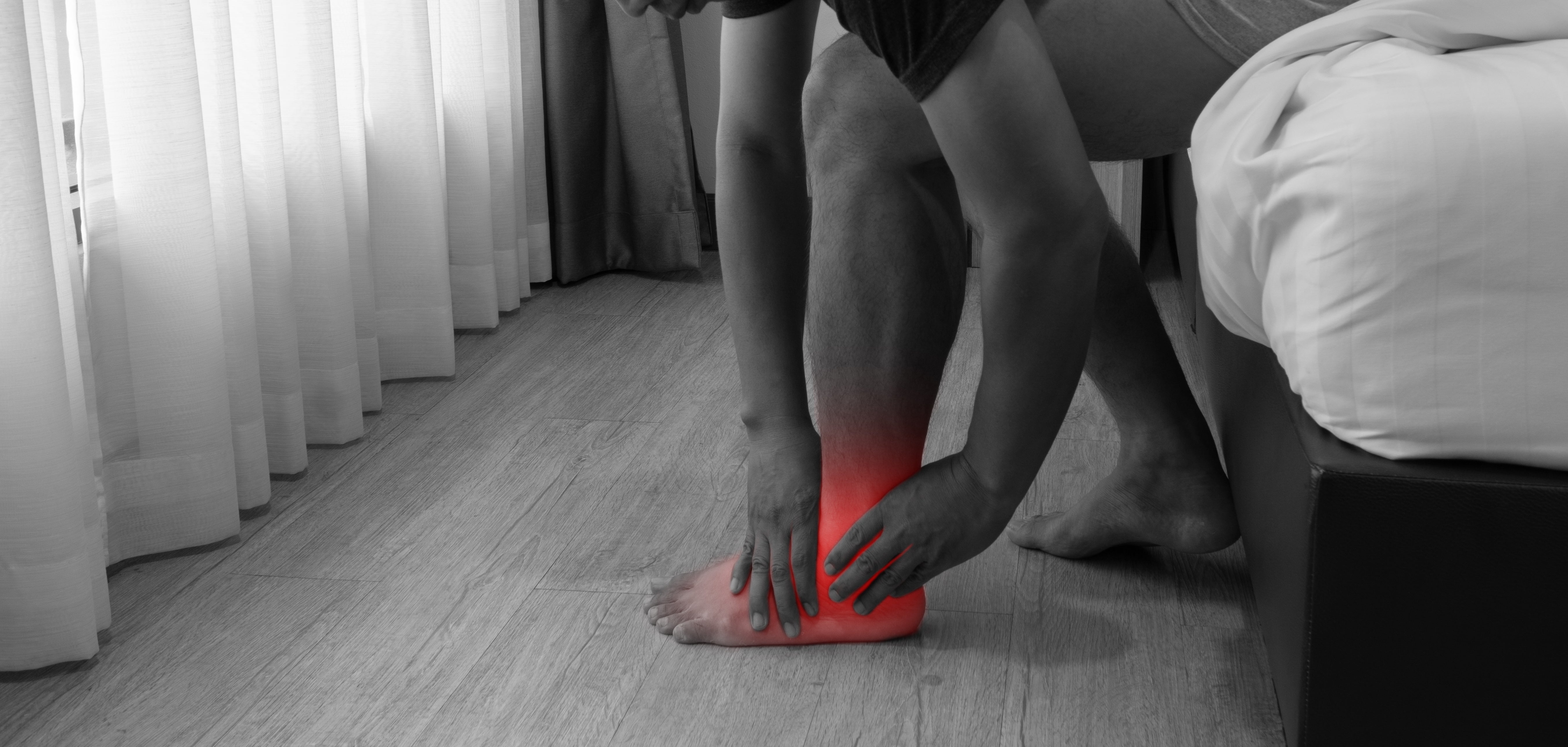
What are heel spurs and what are their symptoms?
Heel spurs, also known as plantar fasciitis, are caused by overuse injury resulting from increased training intensity or added weight on the foot. Common symptoms include pain in the heel or arch when waking up, after long periods of inactivity, or during sports. The pain may subside as the foot warms up but can return under stress or after strenuous activity
How can I relieve and heal from heel spurs?
To relieve heel spurs, it's important to reduce stress on your feet by resting, using special inserts, and wearing comfortable shoes. Exercises, such as toe raises, can increase foot strength and mobility. Consult a physiotherapist for a tailored exercise program. Compression socks may also help by stimulating blood flow and reducing inflammation.
Can running make heel spurs worse?
Running with heel spurs can exacerbate the injury due to increased stress on the plantar fascia. This can lengthen healing time significantly. It's best to switch to low-impact exercises and gradually reintroduce running, focusing on forefoot striking instead of heel striking to prevent reinjury.
How do compression socks help with heel spurs?
Compression socks provide support for the arch of the foot and apply pressure to increase blood flow, which in turn reduces inflammation and supports the healing process. They can be worn during the day for continuous support and are an easy-to-use alternative to traditional taping methods.
Why Choose SPORTSMART for Your Heel Spur Relief?
At SPORTSMART, we understand the discomfort and frustration that come with heel spurs. That's why we offer a comprehensive range of high-quality products specifically designed to alleviate pain and promote faster healing. Our selection includes specialized socks, insoles, and inserts that provide both immediate relief and long-term support for those suffering from plantar fasciitis.
Our compression socks are particularly effective in stimulating blood flow, reducing inflammation, and speeding up the healing process. Brands like OS1st Compression offer both socks and sleeves that provide comfortable support to your feet and heels throughout the day. By choosing SPORTSMART, you're not just buying a product; you're investing in your foot health and overall well-being.
What sets SPORTSMART apart is our commitment to offering expert-approved solutions. We understand that heel spurs can take up to two years to heal completely, which is why our products are designed to support you throughout your recovery journey. Whether you need daytime relief or nighttime support, our range of products caters to all your needs, ensuring you can maintain a normal everyday life while your feet heal.
Don't let heel spurs hold you back. Choose SPORTSMART for reliable, effective, and comfortable heel spur relief products that will have you back on your feet in no time.

